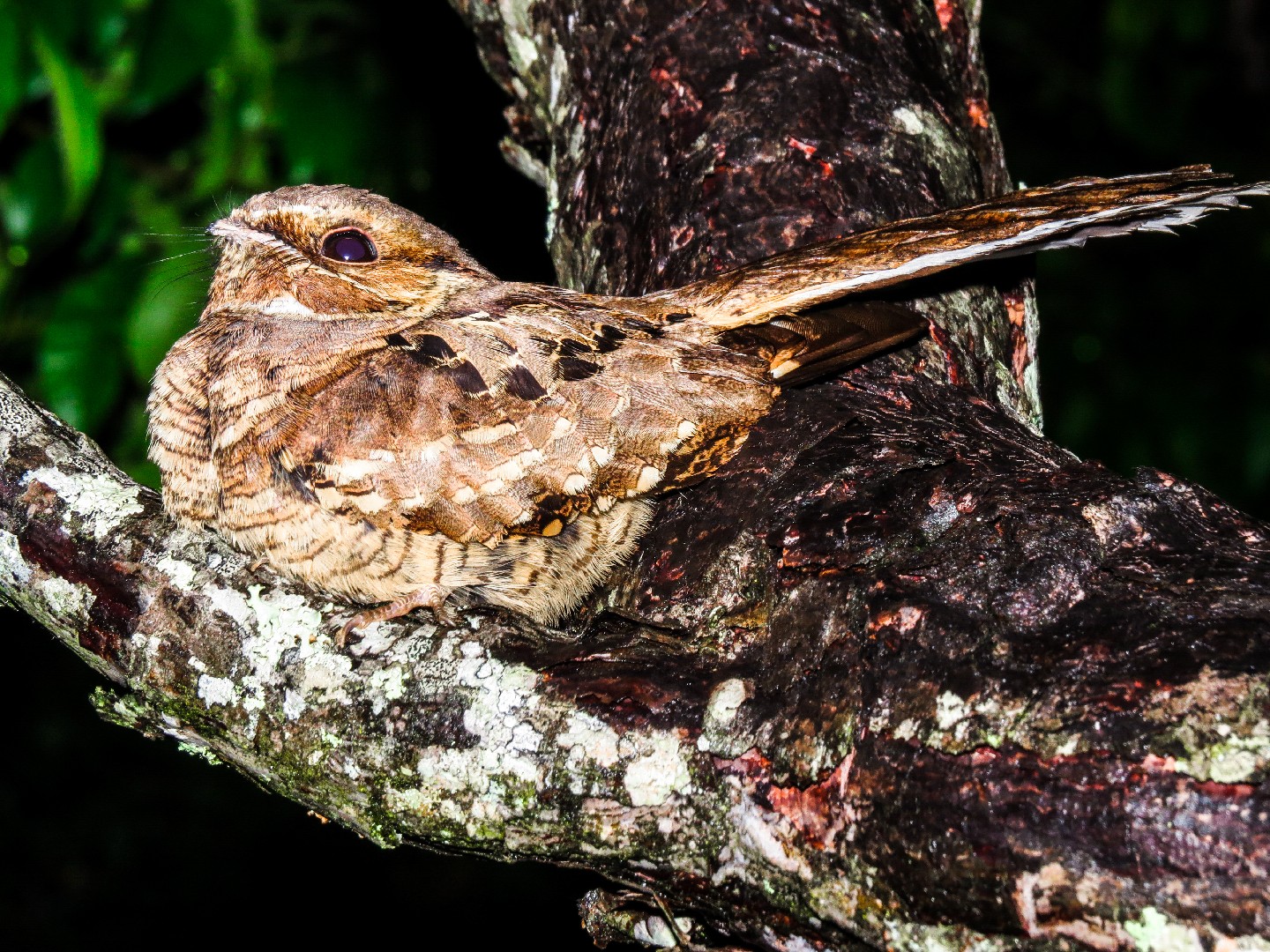Common Pauraque
A species of Pauraque and Scrub Nightjar Scientific name : Nyctidromus albicollis Genus : Pauraque and Scrub Nightjar
Common Pauraque, A species of Pauraque and Scrub Nightjar
Botanical name: Nyctidromus albicollis
Genus: Pauraque and Scrub Nightjar
Content
Description People often ask General Info
 Photo By Fernando Fernandes da Silva , used under CC-BY-SA-4.0 /Cropped and compressed from original
Photo By Fernando Fernandes da Silva , used under CC-BY-SA-4.0 /Cropped and compressed from original Description
This medium-sized nightjar is 8.7–11 in (22–28 cm) long and has two colour morphs, the plumage being variegated greyish-brown or rufous-brown. It is long-tailed and has broad rounded wings. The buff 'eyering' and 'facial stripe' contrast with the reddish sides of the face. The adult male pauraque has a white band near the wing tips, and the outer tail feathers are mainly white. The female's wing band is narrower and the white in the outer tail is more restricted. There are seven subspecies of the pauraque, differing in size and greyness. The male pauraque's song is very variable, but includes a whistled weeeow wheeooo ("who-r-you"), soft puk puk and a whip given in the courtship flight as he flutters around the female. Her call is a rapid succession of whip sounds. 
Size
26 cm (10.11 in)
Nest Placement
Ground
Feeding Habits
Common Pauraque targets night-flying insects like beetles and moths from open areas or perches. They display leaping and short flights for capturing prey. Their diet includes various insects, occasionally consuming seeds and grit to aid digestion.
Habitat
Common Pauraque inhabits diverse open and semi-open terrain from Mexico to northern Argentina, favoring the lowlands. This bird thrives in habitats ranging from light woodlands and brushlands to mangroves and forest edges. Adaptable, common Pauraque also makes home in altered landscapes like agricultural areas and coffee plantations, often found in savannas known as llanos, and adept at exploiting new open spaces for hunting.
Nest Behavior
Common Pauraque lays eggs directly on the ground. The timing of nest building coincides with breeding season, and both parents participate in caring for the eggs and the young once hatched.
Nest Characteristics
Common Pauraque's nest is not a structure but rather a simple arrangement on the ground, often concealed beneath a bush in brushy or wooded field edges, using the existing ground or fallen leaves as its base.
Dite type
Insectivorous
People often ask
General Info
Feeding Habits
Bird food type
Sounds
Song
Recording location: Panama
Song
Recording location: Suriname
Behavior
Common Pauraque are primarily nocturnal, engaging in most of their activities like singing and foraging from dusk till dawn, favoring moonlit nights. Perched low on rocks or stumps, males vocalize to establish presence, occasionally leaping as they do so. Post-sunset, pairs may fly together, hinting at their monogamous nature. Uniquely, male common Pauraque are unusually involved in egg incubation, sharing the task more equally with females compared to other nightjar species, showcasing their distinctive parental behavior.
Distribution Area
The breeding range of the common pauraque extends from southern Texas to the lower Paraná River region. Most populations are all-year residents, although the U.S. breeders (N. a. merrilli) may winter in eastern Mexico. At the southern end of its range, subspecies N. a. derbyanus ranges from central and southern Brazil into the adjacent parts of Bolivia, and through Paraguay into Argentina and Uruguay. Even the southernmost birds seem to be nonmigratory, but at the limit of its range the species is only patchily distributed. For example, it is not recorded to breed in Entre Ríos Province (Argentina) and it is scarce in Rio Grande do Sul (Brazil); about its presence in Uruguay likewise little is known, except that a population of some size is found along the Yaguarón River in the Cuchilla de Mangrullo region. It is found in open woodland/grassland habitats, but also scrubland and crop fields. This species has long legs (by nightjar standards) with bare tarsi, and is more terrestrial than most of its relatives. If disturbed, it will sometimes run rather than fly, and it frequently rests on roads and tracks. In general it prefers mixed habitat which offers densely vegetated hiding places – ideally forest – for the day, as well as open landscape – perhaps even rivers or wetlands – to hunt at night. The pauraque is nocturnal, like other nightjars, and starts to fly at dusk. Like its relatives, it feeds on insects caught in flight, usually by flycatching from a low perch, but also by foraging over open ground. No nest is made; the two elongated and elliptical pinkish eggs are placed upon the bare ground or leaf litter. Not globally threatened, it is considered a Species of Least Concern by the IUCN. Being an adaptable species that will tolerate human disturbance of habitat well, the pauraque has actually benefitted from limited deforestation. Logging creates areas of low and secondary growth in which the birds are able to hunt more efficiently. However, it will of course abandon heavily built-up or clear-cut locales, and, in addition, it is very vulnerable to predation by feral dogs and cats, disappearing from areas where these pests are abundant. 
Species Status
Not globally threatened.

 Photo By Fernando Fernandes da Silva , used under CC-BY-SA-4.0 /Cropped and compressed from original
Photo By Fernando Fernandes da Silva , used under CC-BY-SA-4.0 /Cropped and compressed from original Scientific Classification
Phylum
Chordates Class
Birds Order
Nightjars and Relatives Family
Nightjars and nighthawks Species
Common Pauraque